Understanding How Future Ocean Climates Will Affect Fisheries
Using powerful computers, climatologists and oceanographers are now able to model global changes in the ocean and atmosphere with greater confidence and for increasingly smaller areas than ever before. This advance is transforming NOAA’s ability to understand the impact of climate change on the science of fisheries management. This understanding will ultimately help us set fishing quotas and ensure productive fish populations for the future.
When people who harvest fish reel in lines or haul in nets, their catches reflect the interactions among marine species and the habitats and environmental factors existing where these species live. In the past, managing a fishery rarely focused on more than one species and almost never included consideration of how climate or environmental change might alter fish populations and the quantity of fish available to harvest. Understanding the combined impact of the ocean environment, climate, harvest, and species interactions on marine fish populations is essential to managing fisheries for sustained populations and harvest levels.

Fishing is a $40 billion per year industry in the United States. Understanding the combined impact of climate and harvest on marine fish populations is essential for sustainable fisheries management. Click image for larger view and image credit.
To understand how climate change affects marine ecosystems, including fisheries, NOAA conducts and sponsors research on global ocean ecosystem dynamics, through a program known as GLOBEC (short for GLOBal ECosystems).
GLOBEC is an international program with studies underway in several nations, as well as a joint international program in the Southern Ocean off Antarctica. NOAA conducts studies in the Pacific and Atlantic Oceans for the U.S. component of GLOBEC. Results from these studies will be integrated with GLOBEC programs from other nations to give a global view of the effects of climate change on marine populations.
GLOBEC research approaches the complex problem of understanding how climate impacts ecoystems on two interrelated fronts:
- Studying the oceanic processes that control and influence the behavior and population levels of marine fisheries in specific regions. Data from field studies that take place on local scales will allow scientists to incorporate that knowledge into biological models that can be combined with physical climate models.
- Linking biological models with physical climate models on a global scale. These so-called “coupled” models help predict the local impacts of global climate change and the local consequences of that change on ecosystems and fisheries.
This article explains how GLOBEC has enabled scientists to combine biological and physical models at widely different scales of resolution.
Evolution of Global Climate and Ecosystem Modeling
Studying global ocean ecosystem dynamics brings together climatologists, fisheries scientists, and marine ecologists to examine the interrelated nature of climate and marine ecosystems. Climatologists have long studied the Earth’s climate using computer models of ocean and atmospheric interactions to predict changes in the coming years and decades. These models traditionally predict increases in air and water temperatures and changes in wind patterns and rainfall on a global scale. Higher air temperatures will lead to increases in water temperatures and melting sea ice. Greater rainfall will increase freshwater runoff into the sea, which can impact its salinity. These factors can change the position and strength of major ocean currents. Marine ecologists and fishery scientists expect these changes to have direct consequences for marine ecosystems.
In just the last 15 years, the computers and computer models used to simulate climate change have grown in sophistication, allowing scientists to gain a better picture of how climate can influence ecosystems.
Global Climate and Ecosystem Modeling: The Way It Was
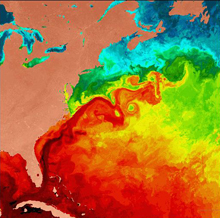
Satellite image of Atlantic sea surface temperatures showing the Gulf Stream current flowing north from Florida. Global climate changes could lead to shifts in the location and strength of major ocean currents.
In the mid-1990s, prior to GLOBEC, computers could run global climate models that used data from only a limited number of points on Earth. In those years, a global climate model commonly would calculate and project climate characteristics based on data at points on the globe roughly 180 miles (290 kilometers) apart. Since many coastal features such as estuaries are smaller than this, these models were unable to predict the effects of climate change in regions that small. Computer capacity also limited the ability of early climate models to predict how climate would impact individual species or ecosystems.
For the most part, scientists modeled physical and biological systems separately. This approach ignored the interrelated nature of the two systems. Scientists studying global ocean ecosystem dynamics needed a new type of affordable computer model to represent the local ecological impacts of global climate changes.
Global Climate and Ecosystem Modeling: The Way It Is
Today’s computers are much more powerful than those of the mid-1990s, but still not powerful enough to represent all climatic processes of interest everywhere on the globe simultaneously. Nested computer models gave GLOBEC scientists a solution to this problem.
Nested models cover smaller geographic areas and use data from a larger number of more closely spaced points set within a standard global model. The global climate model predicts globally, while the nested models predict the local response to results from the global model. This nesting technique had been used to model the atmosphere but, until GLOBEC, had not been extensively used to model oceans and marine ecosystems.
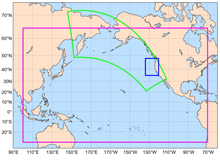
Areas defined by the colored boxes help illustrate how GLOBEC scientists use nested computer models within successively smaller geographic areas. Click image for larger view and full caption.
At a local scale, GLOBEC models predict marine ecosystem response to global climate change about every two miles (three kilometers). This is the appropriate scale needed to represent some of the important physical and ecological processes in coastal regions.
Along with developing these nesting techniques, GLOBEC scientists introduced ecosystem processes from biological models directly into physical climate models. By combining these models, scientists will be able to predict not only the local impacts of global climate change, but also the local consequences to ecosystems and fisheries.
Understanding Ecosystem Response to Climatic Change
To better understand how fisheries and marine ecosystems respond to changes in environmental conditions, GLOBEC scientists conducted two long-term studies that illustrate a new level of understanding of ocean ecosystem dynamics: (1) Fluctuating Pacific Salmon Populations and (2) Water Masses on the Atlantic’s Georges Bank. Data generated from these studies are now available for the biological models that nest within global climate models.
Fluctuating Salmon Populations

Coho salmon. GLOBEC scientists studied coho, chinook, and pink salmon to better understand how global climate and oceanic processses influence these species in coastal Gulf of Alaska and in the northern part of the California Current off the Oregon coast.
In the Pacific, scientists noticed interesting relationships between the numbers of salmon returning to rivers in Alaska and Washington/Oregon – when the Alaska returns were high, the Washington/Oregon returns were low, and vice versa. Scientists theorized that these trends could be tied to changes in ocean temperatures. In addition, most previous salmon studies examined the freshwater phase of a fish’s life cycle. But, after salmon enter rivers and spawn, the newly hatched fish find their way downriver and into the ocean to spend one to eight years at sea, depending on the species. This oceanic phase of a salmon’s life was largely unexplored, and it was unclear what ocean influences were at work on the young fish.
GLOBEC studies focused on the coastal ocean areas of Oregon and Alaska, measuring the atmospheric conditions, ocean currents, temperature, nutrients, prey, and predators that could impact juvenile salmon. Scientists found that the salmon returning to rivers in the coastal systems in Alaska and Oregon do not always occur in the opposite relationship that scientists believed they had observed.
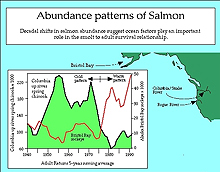
Numbers of salmon returning to Alaska and Washington/Oregon showed opposite patterns from 1950-1990. Click image for larger view, image credit, and full caption.
Different species can react differently to changes in ocean conditions. Coho salmon seem fit the pattern of the opposite relationship described earlier. That is, when the coho population increased in Alaska, coho in Oregon seemed to decrease in numbers. However, chinook salmon did not follow these same trends. These species differences could be due to differences in where the salmon spend their first year at sea. Juvenile chinook salmon are much closer to shore than young coho salmon. This could expose the two salmon species to different ocean conditions or levels of predation.
GLOBEC provided the data sets to analyze what really happens to young salmon during their oceanic life phase. Conditions that are good for salmon growth and survival can be compared to time periods when growth was poor and death rates were high. By analyzing these conditions and putting this information into biological models linked with the physical models, researchers can predict salmon returns to rivers in the Pacific Northwest and Alaska. Preliminary predictions are currently available. While not yet incorporated into fishery management plans, information such as that gained from this study will be crucial as fishery management becomes more ecosystem-based.
Water Masses on the Atlantic’s Georges Bank
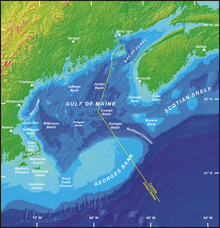
GLOBEC studies have shown that water coming onto Georges Bank (light blue region at the bottom of the map) from the northeast brings nutrients and animals that influence how populations on the Bank grow and reproduce. Click image for larger view and full caption.
In the northwest Atlantic, fisheries experts used to consider Georges Bank to be an enclosed system, with water currents circling clockwise around the Bank. They also knew that water from deeper ocean areas northeast of the Gulf of Maine occasionally made it onto the Bank. But, they considered this to happen infrequently and to be relatively unimportant to the biology of the region.
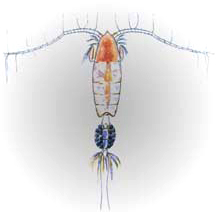
GLOBEC scientists on Georges Bank studied major fish species like cod and haddock along with their major food source, a small (about 1/8 inch) shrimp-like creature (shown here) called a copepod.
GLOBEC studies of ocean dynamics showed that the water coming onto Georges Bank on its northeast edge is one of the most dominant factors in year-to-year biological differences. These waters can carry nutrients and animals from outside Georges Bank and influence how the populations on Georges Bank grow and reproduce. The amount of water that crosses onto Georges Bank is linked to atmospheric conditions over the north Atlantic and can be tied to climatic variables. Thus, climate influences from elsewhere in the Atlantic can cause water masses to be transported onto the Bank and result in important effects on biological productivity.
Climate models can predict in advance whether and how much water will enter the Gulf of Maine and Georges Bank. Biological information from field studies can provide knowledge about how that water influences fish populations and their prey, and this can be incorporated into biological models. Coupling these two types of models is a powerful way to predict the future success of fish populations on Georges Bank. Incorporating this knowledge into fisheries management will enable planning for future ocean conditions.
Conclusion
Before GLOBEC, NOAA scientists analyzed rates of growth, death, and reproduction for fish populations largely without considering ocean circulation and physical conditions. GLOBEC influenced scientists to take an ecosystem approach to understanding fish populations by combining climate studies, physical oceanography, fisheries biology, marine ecology, and computer modeling into a coordinated research program. Now it is common for NOAA scientists to conduct interdisciplinary studies in order to apply an ecosystem approach to fisheries management.
The advances made in understanding how ocean ecosystems work, and how they are influenced by climate, would be less useful without a framework that can predict specific effects. Through GLOBEC, scientists are developing computer models to link global climate predictions to local regions and include biological models to predict ecological effects. These models will help to plan for predicted climate effects and protect fishery resources for future generations.
Works Consulted
GLOBEC. Global Ocean Ecosystem Dynamics Web site. Retrieved March 2007, from http://www.globec.org.
Richert, E. and Incze L., Eds. (2003). Prototype Biophysical Maps of the Gulf of Maine. Gulf of Maine Area Program of the Census of Marine Life. Portland, Maine. University of Southern Maine.
Special Issue: U.S. GLOBEC. (2002). Oceanography 15(2). Rockville, Maryland.The Oceanography Society.
U.S. Commission on Ocean Policy. (2004). An Ocean Blueprint for the 21st Century: Final Report of the U. S. Commission on Ocean Policy [Electronic version]. Washington, DC. Retrieved March 2007, from http://www.oceancommission.gov/documents/
full_color_rpt/welcome.html.
U.S. GLOBEC. (2001). U.S. GLOBEC: Ocean Physics, Marine Ecosystems, Climate Change. Silver Spring, Maryland.National Oceanic and Atmospheric Administration and National Science Foundation. 12 p.
U.S. GLOBEC Georges Bank Web page. Retrieved March 2007, from http://globec.whoi.edu/globec.html.
U.S. GLOBEC Web site. Retrieved March 2007, from http://www.usglobec.org.
U.S. GLOBEC Northeast Pacific Homepage. Retrieved March 2007, from http://globec.oce.orst.edu/groups/nep/index.html
Wiebe, P., Beardsley, R., Mountain, D., and Bucklin, A. (2002). U.S. GLOBEC Northwest Atlantic/Georges Bank Program. Oceanography 15(2):13-29.Rockville, Maryland.The Oceanography Society.
